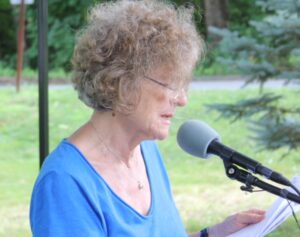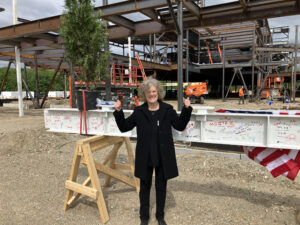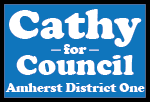ACHIEVEMENTS AS COUNCILOR AND PRIORITIES FOR ACTION
The first seven years of the Council presented opportunities for positive action, saw heightened budget stress, and stimulated intense debate on zoning, public safety, affordable housing, and budget priorities. By December 2025 I will have served three terms. These years have also provided opportunities to participate in public events.


Elementary School Wins Broad Support
In May 2023, residents gave overwhelmingly support (more than 80% yes) to building a new elementary school that will be the Town’s first public “net-zero” building. I have served as Chair of the Elementary School Building Committee since its inception.
- The broad support reflected the creativity and responsiveness of the design team, hard-work of the committee, and an open transparent process with sustained public outreach.
- In 2023, I made at least 15 presentations to community and District meetings and enhanced the Project Website to address questions.
The school is now under construction and due to open in September 2026. My top priority is to continue to lead this effort, stay on schedule within budget, with an open, public process.
Other Achievements as Councilor Include
With the help and collective action of residents, my efforts to advocate and propose actions have contributed to creation of a new alternative safety workforce, protection of voting rights, improved safety on roads in North Amherst, and responsive capital and operating budgets over the past 5 years.
Areas where I led or co-led as Town Councilor include:
- Initiated a freeze on two police positions to start to fund an alternative safety/responder workforce. 2021-2022
- Led committee to develop a Percent for Art Bylaw. Enacted 2020
- Co-Wrote new wage justice/wage theft bylaws to provide tools to enforce wage, hour, and tipping laws. Enacted 2020
- Retained broad voting access by reversing a decision to consolidate all voting in one place in 2020 elections
- Advocated to expand the inclusionary zoning (affordable) housing Enacted 2021
- Proposed a 6-month moratorium on large buildings downtown to enable better designs for setbacks from street, wide sidewalks, space for stores.
- Secured installation of a new “smart” light at the North Amherst intersection.
- Persuaded State engineers to reduce the speed limit on State Route 63/Montague Road.
- Served as Chair Finance (2025), Chair of the Joint Capital Planning Committee, and Chair of the Elementary School Building Committee from 2019 through 2023.
- This effort included increasing funds to repair roads and sidewalks although the funding falls short of the need.
As Councilor, I come prepared to meetings, research potential alternatives and impacts, listen to constituents, and seek actions that respond to concerns.
My achievements would not have been possible without discussions with residents, and their collective action and advocacy. This was critical in the successful vote for a new school, retaining broad voting access, and enacting an expanded affordable housing bylaw, and obtaining a “smart light” and lower speed limit in North Amherst.
In 2020, Co-Councilors elected me to serve on the Elementary School Building Committee. Committee members elected me Chair. The May 2, 2023 vote by residents to increase property taxes to support the school reflected an intense design and public engagement processes. This included input from school staff to ensure that the school supports a strong educational program and broad support from the community to ensure that the building achieves green, “net zero” goals. (Geothermal heating/cooling and solar panels to provide renewable energy to offset electricity use and costs.)
I also was elected to serve as Chair of the Joint Capital Planning Committee and Chair of the Finance Committee. I will draw what I have learned from in-depth discussions of the Town Budget as we seek to address the fiscal and growth challenges over the next Council term.
Priorities Looking Forward:
If re-elected, my top priorities for action will be to see the new school open and to ensure financial accountability to residents across all Council decisions. We face multiple, competing demands and goals. Action will require planning, prioritizing spending on urgent needs, making decisions based on solid information, and weighing choices and consequences.
SCHOOLS: Invest in strong, excellent schools, including preschools.
Our schools are central to the vitality of Amherst and families across a broad income spectrum. During the next two years, the Town and School Committee will continue to face the challenge of operating with tight budgets.
By consolidating two elementary schools and offsetting utility costs with renewable energy (solar) the new Elementary School will be able to reduce operating costs. However, achieving these savings will not be possible until the School opens in 2026.
A new school is an exciting project and an investment in Amherst’s future. Yet, we will continue to face budget challenges for the elementary and regional schools due to the decline in enrollment, failure of state funds to keep up with costs, and Charter school formula that drains public resources.
- From 1995 to 2022, enrollment declined by more than 1,200 students (down from 3,534 to 2,280 students).
- The Council will need to work with the School Committee, Superintendent to have an informed, transparent discussion of how best to finance and support our schools.
Completing the effort to build the new elementary school with its net-zero design and supporting our schools will be a highlight in 2026.
FISCAL RESPONSIBILITY
Prioritize capital spending by urgent needs to minimize taxpayer impact.
In addition to schools, Amherst has a backlog of costly infrastructure needs, including a critical need to repair deteriorating roads and sidewalks, a public works building that is in critical condition and a new fire station.
- ROADS: Amherst has a backlog of well over $12 million in road repair. This will require expanded State support as well as making this a top annual investment priority. If re-elected, I pledge to focus on ways to augment support of roads and sidewalks
- DPW: The DPW building is in urgent need of repair or replacement, with leaking roof, crumbling walls, and very poor ventilation. Central Fire Station no longer serves us well.
- Given the costs we will need to be creative to respond to the urgent need to act for at least DPW.
On the Finance Committee, I will focus on short and long-term projections of the revenues and costs, obtaining information on choices, and seek ways to prioritize spending on urgent needs with financial accountability.
Over the next two years, we will to face tough choices. This will require transparent, comprehensive, multi-year plan, and efforts to build voter consensus and confidence in the Council’s oversight.
DEVELOPMENT AND GROWTH
Ensure development that enhances the vibrancy of downtown, village-centers and neighborhoods.
How we develop, and zoning changes we adopt matter!
The Council has oversight of town planning and zoning by-laws and the power to enact new bylaws. Zoning bylaws are one of the primary public policy tools that we have to guide and regulate land-use. Seemingly small changes can have large, long-lived impacts.
Broadening the tax base with economic development has been a priority. New developments, if done with a long-term view and thoughtful design, can contribute to the vitality of Amherst, expand affordable housing, address climate change while protecting our open spaces, farms and environment.
But we need to proceed in ways that enhance and build on the historic and educational assets of Amherst, strengthen our Amherst community, and celebrate our small town, quasi-rural quality of life.
People move to Amherst seeking small-town charm, open-spaces, excellent schools and cultural events that would be rare in a town of our size without our colleges and university. To expand the town’s commercial tax base and nurture its cultural vitality, new development has to be physically attractive; it has to draw people to down-town and village centers; it has to include public spaces and sidewalks wide enough to meet and walk; and it has to support new businesses while sustaining existing ones in town.
Realizing these goals requires paying attention to the designs and scale of developments, and the impact of more intense development on other municipal services (increased costs of roads, schools, police, fire, sewer, water systems and more). Parking clearly needs to be a top priority. It is a lifeline for our downtown businesses and community.
Too often zoning changes emphasize density and growth without incorporating the broader vision and elements of planners that advocate “smart growth” and sustainability. Such efforts emphasize the importance of set-backs from the street for wide sidewalks and public spaces; providing space for retail and commercial in downtowns and village centers; ensuring that new multi-family housing includes open green-space; and that developments occur near public transit or provide easy access to food, services, and other necessities.
Climate/Sustainability: Recently building codes have also required that new development, private as well as public, invest stronger “green” sustainability building standards to address climate change. Amherst has adopted stretch codes.
Affordable Housing: The growth of the UMass student population without similarly rapid growth of housing on campus has resulted in a loss of affordable homes in neighborhoods for families and longer-term residents. Despite rapid growth of new apartment buildings, the high rents charged per bed, have put the apartments beyond the reach of moderate and lower-income workers and families.
The Council enacted an expanded Inclusionary Zoning bylaw in 2022 that will require all new multi-unit buildings with 10 or more units to provide a share of “affordable” units. This means rents will be lower for those qualifying based on incomes that are below average. This is a step in the right direction. But more needs to be done – including pressure on UMass to expand its student housing supply.
Sustainability Needs to Include UMass and Colleges to Support of Town Services
Zoning changes have the potential to reshape Amherst with long-lived impacts. Proceeding with caution is essential to devise positive development strategies and work with local businesses to ensure that economic development adds to the economic, cultural, and social life of Amherst and provides affordable housing. The net gain will require making explicit the cost of additional parking and cost of town services (water, roads, sidewalks, fire/police) so that developers share in these costs.
The Council will need work with the Town Manager intensify efforts to forge partnerships with our two colleges and UMass that more equitably share the costs of sustaining Amherst municipal services and schools. The colleges’ and university’s tax-exempt status renders a high share of Amherst’s land nontaxable. Updating agreements to address pressing Amherst needs would ease burdens on residents and businesses and support capital spending on schools, roads, parking and public works.
QUALITY OF LIFE
Improve support for our community’s quality of life and diversity.
Quality of life: We need ways to get around safely – including pothole-free streets, sidewalks and safe intersections. Streets with better bikeways and bus service could also reduce the number of cars downtown and in village centers.
Affordable housing: Affordable rents for low- and moderate-income families preserve diversity and make it possible for employees who work in the town to live in Amherst. I supported and advocated for the expanded Inclusionary Zoning bylaw that will help increase the supply of units available to low income individuals and families with any large developments. I further support making affordable housing a priority for long range planning and support of Amherst Municipal Affordable Housing efforts to act on this priority.
Seniors: The number of Amherst residents who are 65 or older is increasing and approaching the total number of children under the age of 18. As a college and university town Amherst will continue to attract retirees. This is also a great town for healthy aging as long as we assure transportation and support services, including an expanded Senior Center and services for the home-bound.
ENERGY/ENVIRONMENT
Make Amherst more ecologically sound, for the future of the planet.
I support Amherst’s zero-net energy by-law that applies to new municipal buildings and am committed to initiatives that will reduce fossil fuel consumption and foster renewable, sustainable energy.
As a result of successfully applying to be in the pipeline for support by the Massachusetts School Building Authority (MSBA) we are on a path to build a new elementary school that meets our net-zero code. This means that it will be a model of well insulated construction, have daylighting throughout, use electric rather than fossil fuels for energy, and it will generate energy from renewables to offset the school’s electric costs.
I also support Amherst joining with other towns to aggregate electric purchases in a multi-town community energy initiative (Amherst-Northampton-Pelham). This effort is pooling community electric purchases to draw on and stimulate solar and renewable energy sources.
The Energy and Climate Action Committee (ECAC) established by the Council under the leadership of Darcy Dumont, provides recommendations for potential actions that would address Amherst’s climate action goals. With tight budgets, implementing the policies will likely require support from grants and collaborative work with surrounding towns.
Other initiatives include: promoting solar installation, including municipal and community solar on school and public parking lots and replacing fossil fuels as a source of heat in town buildings; strengthening regulations to reduce vehicle “idling” – this could include higher penalties and a “finders” fee such as the used in New York City where citizens receive a share of the fine ($300) for reporting and documenting idling beyond 3 minutes (tougher than the MA law.) A penalty – ticket – for idling and a means of prevention such as citizen reports could avoid consuming police enforcement time.
I included such ideas in response to a questionnaire by the Massachusetts Sierra Club. My replies in addition to my family’s long support of the Sierra Club resulted their endorsing my candidacy. I am honored to be the only candidate endorsed in District 1 in 2018.
ADVOCATE FOR NORTH AMHERST
During the past two terms, I benefitted from the active support of residents of District 1 in North Amherst. Through collective efforts, we were able to get the Town to install a “smart” light at the dangerous intersection by the North Amherst Library. With a petition from residents along and adjacent to Montague Road, plus I letter I wrote making the case the speed was too high, we convinced State engineers to lower the speed limit on this state road.
Unsafe Intersection: I will work with the Town to secure grants to move from ideas to action to reconfigure the dangerous intersection by the Library and Church.
If reelected, I commit to be available, to listen closely, to take time to research issues and options, and to work residents on issues of shared concern. Collective action, not the voice of just one person, will be essential.
We need strong voices for our North Amherst community, including our farms, neighborhood safety, sidewalks, intersections, speed limits, potential zoning, and new developments.
